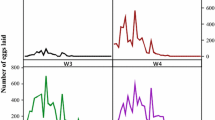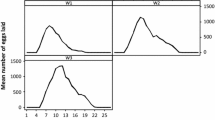Abstract
Findings in the Australian Grey-Headed Flying-Fox,Pteropus poliocephalus, have elucidated the life-cycle ofToxocara pteropodis. In adult bats, other than parturient females, larvae were found only in the livers. Following parturition, larvae were recovered only from mammary glands up to 2 weeks post-partum. Developing larvae were found only in the intestine of young bats from the age of two days onwards; there was no evidence of pulmonary migration.
The evidence indicates that juvenile bats commence passingToxocara eggs in their faeces at about 2 months of age and expel the worms spontaneously following weaning at about 5 months. The eggs passed in the faeces of the young bat and its mother are disseminated through-out their environment and embryonate rapidly, being infective to mice after 10 days. Under natural conditions the eggs remain viable for 6 weeks or less and are infective to bats by the oral route.
Similar content being viewed by others
References
Baylis HA (1936) A new ascarid from a bat. Ann Mag Nat Hist Ser 10, 17:360–365
Byth S (1980) Palm Island mystery disease. Med J Aust 2:40
Dubey JP (1978) PatentToxocara canis infection in ascarid-naive dogs. J Parasitol 64:1021–1023
Green R, Tonder SV van, Oettle GJ, Cole G, Metz J (1975) Neurological changes in fruit-bats deficient in vitamin B12. Nature 254:148–150
Hall LS, Richards GC (1979) Bats of Eastern Australia. Queensland Museum booklet No. 12
Mickelsen O (1956) Intestinal synthesis of vitamins in the non-ruminant. Vits and Hormones 14:1–95
Moorhouse DE (1982) Toxocariasis — a possible cause of the Palm Island mystery disease. Med J Aust 1:172–173
Nelson JE (1965a) Behaviour of Australian Pteropidae (Megachiroptera). Animal Behaviour 13:544–557
Nelson JE (1965b) Movements of Australian flying foxes (Pteropodidae: Megachiroptera). Aust J Zool 13:53–73
Ratcliffe FN (1931) The flying-fox (Pteropus) in Australia. Bull Coun Sci Ind Res Aust 53:1–80
Sprent JFA (1958) Observations on the development ofToxocara canis (Werner 1782) in the dog. Parasitology 48:184–209
Warren EG (1971a) Studies on the morphology and taxonomy of the genusToxocara Stiles, 1905 andNeoascaris Travassos, 1927. Zool Anz 185:393–442
Warren EG (1971b) Observations on the migration and development ofToxocara vitulorum in natural and experimental hosts. Int J Parasitol 1:85–99
Author information
Authors and Affiliations
Rights and permissions
About this article
Cite this article
Prociv, P. Observations on the transmission and development ofToxocara pteropodis (Ascaridoidea: Nematoda) in the Australian Grey-Headed Flying-Fox,Pteropus poliocephalus (Pteropodidae: Megachiroptera). Z. Parasitenkd. 69, 773–781 (1983). https://doi.org/10.1007/BF00927426
Accepted:
Issue Date:
DOI: https://doi.org/10.1007/BF00927426




